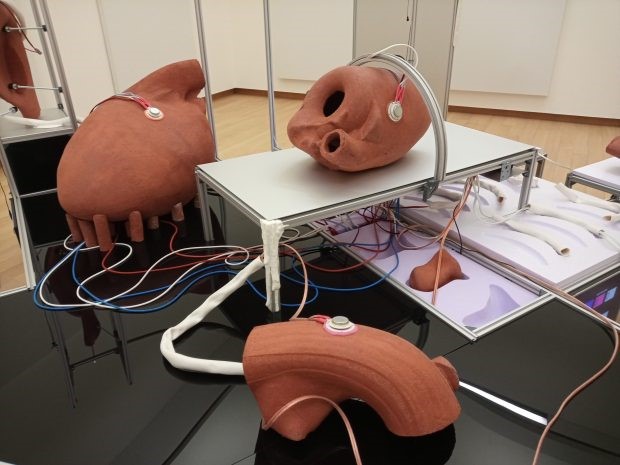“INTERPERSONAL BIOFEEDBACK APPARATUS ENCODING CARDIAC FLUCTUATIONS”, CORALIE VOGELAAR (NL)

Title of the artwork: Interpersonal Biofeedback Apparatus Encoding Cardiac Fluctuations
Author: Coralie Vogelaar
Date: 2021
Source:
https://images0.persgroep.net/rcs/5GKeonq1tygjoSCajmipvM03SNU/diocontent/209784635/_fitwidth/763?appId=93a17a8fd81db0de025c8abd1cca1279&quality=0.8
ARTWORK ABSTRACT
Interactive installation exploring the relationship between machines and people through a sensor chamber, wires, speakers and enlarged parts of the heart made of ceramic. Visitors can sit on a stool and hang a sensor on their earlobe. Everyone has a screen in front of them showing their own and other participants’ heartbeats.
GET INSPIRED
When you enter this installation, resembling a laboratory or operating room, and as soon as people take a seat, the work automatically attracts more visitors. You become not only curious, but intrigued by how to produce new sounds. At that moment, you see the visitor next to you jump to increase their heart rate, or they try to startle each other to change the frequency of the heartbeat. A burst of laughter results in wild sounds, which in turn stimulate other visitors to laugh.
Changes in the heartbeats of all participants create sounds. As soon as someone’s heart rate drops or increases, there are different tones. The play comes to life.
WHAT DOES THIS WORK TRANSMIT TO US?
What materials / media are used in the work and why?
This work is an interactive installation. It consists of a 10-channel audio installation, ceramic pieces representing parts of the heart, aluminum, vibration speakers, sensors, foam panels, methacrylate, and composition software.
SuperCollider algorithmic composition software.
The installation examines our need to exert control over our bodies, the uncontrollable nature of the conditions that influence how we feel, and the data systems that analyze our state of well-being. Visitors are invited to take a seat and place a sensor on their earlobe. The variability of their heart rate, the period between heartbeats, becomes immediately audible in the form of metallic ticking, ceramic friction sounds, and squeaking polystyrene. Changes in HRV directly impact musician Sjoerd Leijten’s sound composition, and vice versa.
The sensors record all the irregularities of the heartbeat, which fluctuates in response to physical and emotional factors. Because of the complexities involved in identifying the cause of individual fluctuations, science often dismisses small variations as irrelevant, and only average readings are used for tests.
Coralie Vogelaar explores the “noise” that usually filters through medical examinations to incorporate it into this hybrid mix of technological research and fine art: the installation emanates the atmosphere of a laboratory, with its aluminum tubes, visible wires, sample tables, etc. Vogelaar demonstrates that our states of mind are more complex than an averaged measure would suggest. She embraces this complexity by combining data sampling systems with the physical experience of sound, rather than imposing any scientific framework or delimitation.
What is the significance of the elements of the work?
All of us who use a portable device to measure our heart rate are used to that information being private. Normally you can see what your own heart rate looks like at any given moment, but through this work it becomes public, not only to those who participate, but also to everyone who passes through the room.
The data that is normally so cold on our wearable device or smartphone fills the space.
Our smart phones, smart watches and other wearable devices constantly collect data about our health. Our heart rate is tracked throughout the day and every step is counted. It has become normal to see our bodies presented more and more in cold numbers, in an almost haunting way.
We can see exactly how many hours we’ve slept each morning. Instead of asking me what night it was, what happened that night, my smartphone displays a number that identifies that night’s sleep. On another screen I see my skin temperature, oxygen saturation and breaths per minute, among other things.
There is a danger that this data can become an obsession. That every little change makes you anxious, or that you start worrying more about hours of sleep on your smartphone than actual sleep. There are people who move their arms just to take 10,000 steps, because that arbitrary number becomes more important than taking a healthy walk.
The artist demonstrates with her work how uncomfortable, but also enjoyable, it is to let go of that control. Wearables can do a lot of good for our health, but how we feel should always come first.
About the artist
Coralie Vogelaar is an interdisciplinary artist who combines scientific disciplines such as human behavior, studies and data analysis with artistic materials. Fascinated by algorithms, she explores the relationship between human and machine, collaborating with experts from various fields of knowledge, creating work of a collaborative nature. Through her work she addresses underlying themes through works with a strong visual component.
Author of the analysis: Amalia Ortega Rodas
